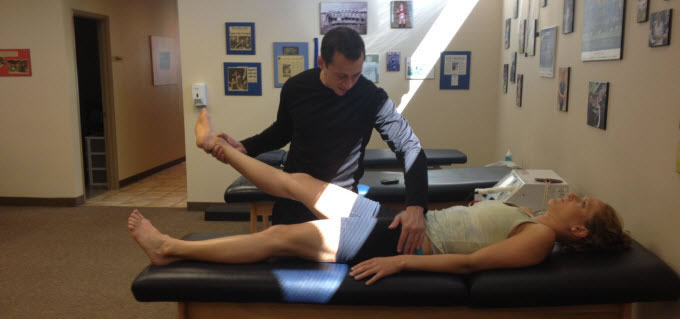Muscle Activation Techniques (MAT): Mobilizing the Muscle-Brain Connection
Mobility Treatment Corrects Muscular Imbalance
By Amanda Frank, Hugo Mobility
Mobility issues affect a lot of us, to many varying degrees. In fact, difficulty walking is experienced by 27 percent of people ages 50 to 75. If you find you or a loved one among the ranks, chances are you manage your health with a regimen that involves of working with a physiotherapist and possibly other complementary therapists. There’s a growing probability that one of them is specialized in Muscle Activation Techniques (MAT), a trending new manual therapy that aims to correct muscular imbalances. According to Greg Roskopf who began developing MAT twenty-five years ago, the key to building strength is through reducing tightness and increasing range of motion.
Roskopf posits that tightness is a symptom of muscle weakness, and it’s actually caused by faulty wiring of the neuromuscular system preventing information from getting to the muscle from the brain. Without the proper signals, muscles tighten up as a defensive mechanism, resulting in pain, inflammation and limited mobility. MAT aims to restore those neuromuscular pathways in order to slow, or even reverse the progression of muscular dysfunction that causes weakness and muscular imbalances.
The principal is the same for aging seniors who use mobility aids to compensate for weakness or balance issues.
“Simplistically, the body instinctively tightens up as a protective mechanism to stabilize itself. It’s the body’s way of bracing itself to prevent injury,” says Roskopf. “Think of what happens when you walk on ice. Your muscles tighten up to protect you from losing your footing.”
“As we age, this instability becomes an internal issue, maybe part of the muscular system itself becoming dysfunctional, causing the same neurological response as walking on ice, to take shorter strides and limit their range of motion. The goal of MAT is to melt the ice, provide a sense of stability. If you do that the body will provide all the mobility in the world.”
Mobility aid users may also need to consider a therapy like MAT for treating problems associated with the use or misuse of mobility aids. Even a well fitted cane will put some strain on the shoulder and wrist. One that isn’t properly adjusted will compound the strain on the body. On top of weakness and imbalance, the body is forced to compensate for misalignment caused by prolonged use, which can contribute to fatigue, pain, inflammation or other secondary problems.
More like an electrician
While other therapies treat tightness directly using stretching or massage, MAT treats the muscular dysfunction as a neurological disorder. Using digital manipulation of the muscle (manually pressing and palpating) MAT trains the muscles and brain to work as a connected system. Imagine trying to start a car without a battery. Much the same way, MAT aims to restore the electrical pathways between the muscle and the brain. By patching that channel of communication between the muscle and the nervous system the chance of injury is reduced.
This technique involves palpating the muscle where it attaches to bone, called the points of origin and insertion, and retraining the brain to fire the muscle and connecting muscles.
Helps Neuropathy related conditions
In cases of walking difficulties caused by a neuropathy-related muscular imbalance that sensory input is coming from the feet. Think of your hand on a hot stove. The sensors in your hand, which belong to the peripheral nervous system, carry information to your brain, the central nervous system. The brain processes the sensory input and creates a mechanical response, namely removing your hand from the burner.
People with Fibromyalgia and chronic fatigue experience symptoms because the tolerance level of the muscle is very low. The goal of MAT is to improve sensory responsiveness in the tissue by strengthening the muscle. Strengthening the muscle allows the tissues to recover.
Isolate-based therapy
Unlike movement-based therapy therapies such as yoga or Qi Gong, MAT is an isolate-based technique. Similar to the way mechanics works on cars, MATs examine the body in stasis as an integrated system and isolate the dysfunction. MAT practitioners want to know what you can’t do. When a movement is activating a muscle that is weak, other stronger, synergistic muscles will compensate. MAT aims to resolve the perpetuation of strong muscles getting stronger and weak muscles staying weak.
Part of the exercise continuum
While it does show results in the short-term, MAT is not a quick fix. It’s a process that provides long-term benefits but requires long-term treatment. MAT should be viewed as a preventative treatment part of a holistic exercise continuum, as opposed to a rehabilitative technique.
As follow up between treatments, clients are prescribed exercises to perform at home. Roskopf recommends going for a tune up once a month as part of your regular maintenance regime. “Life is going to beat us up,” said Roskopf, “somebody has to keep that muscle system working at a high level.”
Based in Denver, Colorado, MAT’s founder Greg Roskopf holds a Master’s Degree in Exercise Science and is a former collegiate strength coach with an extensive background in sports training, biomechanics, muscular function, strength and conditioning. His program has trained and certified over 1,500 specialists in the US, Mexico, Canada and Barcelona since 2000.To learn more about MAT or find a specialist in your area contact the office at www.muscleactivation.com.
Hugo Mobility extends a special thanks to Ryan Cohen, personal trainer and MAT trainer, for introducing us to Muscle Activation Techniques and Greg Roskopf.
(Source: LaPlante, Demographics of Wheeled Mobility, 2003)




 and get Cash rewards!
and get Cash rewards!